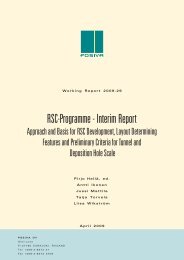A review of porosity and Diffusion in Bentonite (pdf) (2.4 MB) - Posiva
A review of porosity and Diffusion in Bentonite (pdf) (2.4 MB) - Posiva
A review of porosity and Diffusion in Bentonite (pdf) (2.4 MB) - Posiva
You also want an ePaper? Increase the reach of your titles
YUMPU automatically turns print PDFs into web optimized ePapers that Google loves.
19More simply, the <strong>in</strong>dividual concentrations <strong>in</strong> DDL water can be calculated by averag<strong>in</strong>gthe potential <strong>in</strong> DDL water, <strong>and</strong> calculat<strong>in</strong>g the concentration with Boltzmann’sequation: - ziFDDLcDDL, i ciexp(34) RTwhere ψ DDL is the averaged potential <strong>in</strong> DDL water. Appelo <strong>and</strong> Wers<strong>in</strong> (2007) haveshown that the averaged concentration gives an accurate approximation for the totalconcentration that follows from <strong>in</strong>tegrat<strong>in</strong>g the exponential concentration distribution <strong>in</strong>the DDL. With Equation (34), the flux through DDL water can be calculated as shown<strong>in</strong> the next section.3.2 Which concentration gradient should be used?Many authors, cited before, distribute a high proportion <strong>of</strong> the mass <strong>of</strong> cations to DDL<strong>and</strong>/or <strong>in</strong>terlayer water, <strong>and</strong> calculate the diffusive flux without realiz<strong>in</strong>g that the driv<strong>in</strong>gforce for diffusion is not the concentration, but the concentration gradient (formally, thepotential gradient). Imag<strong>in</strong>e two tubes, one filled with 1 M NaCl, the other with 0.01 MNaCl, while the concentration gradient is the same <strong>in</strong> both tubes. If the flux <strong>in</strong> the ensembleis weighed accord<strong>in</strong>g to concentration, the flux would be 99 % located <strong>in</strong> thetube with the 1 M NaCl solution. But <strong>of</strong> course, the flux is the same <strong>in</strong> the two tubes.Actually, because the activity coefficient is somewhat smaller <strong>in</strong> 1 M solution, the flux<strong>in</strong> that solution is slightly less.In free porewater <strong>and</strong> DDL water the molal scale is used for the activity <strong>of</strong> solutes(mol/kg H 2 O, divided by 1 M to arrive at a dimensionless number). The flux <strong>in</strong> freeporewater is, from comb<strong>in</strong><strong>in</strong>g Equations (20) <strong>and</strong> (29), assum<strong>in</strong>g γ i = 1:Jfree,i free dci free D2 w,i(35) dxfreeAppelo <strong>and</strong> Wers<strong>in</strong> (2007) have shown that the potential gradient <strong>in</strong> free porewater alsoapplies to diffusion <strong>in</strong> DDL water. Thus the flux through DDL water follows fromEquations (14-15), (29) <strong>and</strong> (34):JDDL,iDDLcDDL,idci DDLD2 w,i(36) c dxDDLiFor exchangeable cations <strong>in</strong> <strong>in</strong>terlayer water the molar- or equivalent-fraction is thecommonly used concentration scale. Both molar- <strong>and</strong> equivalent-fraction scales are wellestablished by experience <strong>and</strong> experiment, <strong>and</strong> expla<strong>in</strong> typical aspects <strong>of</strong> ion exchangesuch as dilution <strong>and</strong> retardation <strong>in</strong> a complex mixture <strong>of</strong> cations (Appelo <strong>and</strong> Postma,2005). The choice between the equivalent <strong>and</strong> the molar scale is mostly a matter <strong>of</strong> convenience(Ga<strong>in</strong>es <strong>and</strong> Thomas 1953). The equivalent scale has the advantage that thesum <strong>of</strong> the exchangeable cations equals the CEC (a more or less fixed number), <strong>and</strong> willbe used here.
















